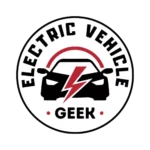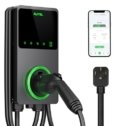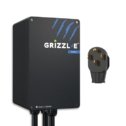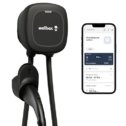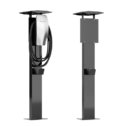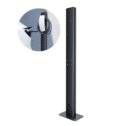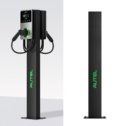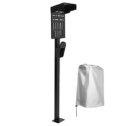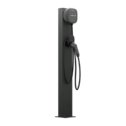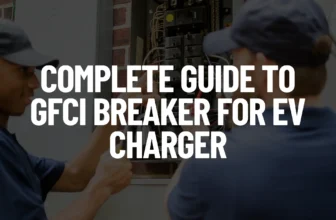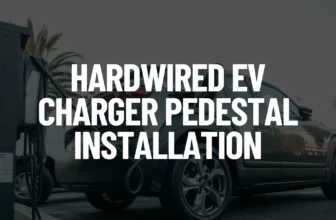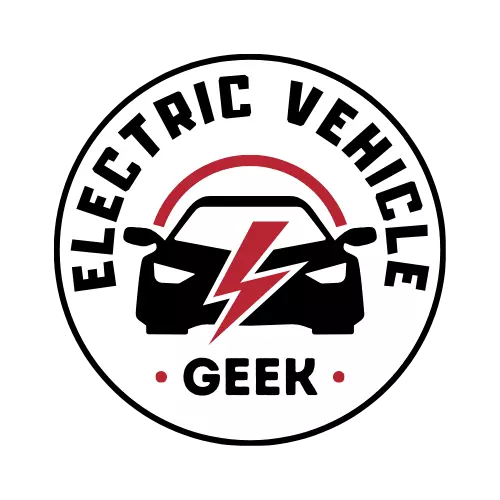While hardwired EV charger pedestal installations are more common, plug-in EV charger pedestal installations are growing in popularity – and for good reason. We recommend plug-in EV charger pedestal installations for homeowners who want the flexibility of a portable EV charger combined with the convenience of a semi-permanent setup.
We call these installations semi-permanent because, although the EV charger can be unplugged and used elsewhere, the pedestal is fixed. This hybrid approach works well in both residential and commercial settings.
Table of Contents
- For Homeowners
- For Businesses
- What Is a Plug-in EV Charger?
- What Is an EV Charger Pedestal?
- Plug-In EV Charger Pedestal Installation Guide
- Plug-In EV Charger Pedestal Installation Notes
For Homeowners
Plug-in EV charger pedestals are ideal for homeowners who want a portable charger but don’t have a nearby NEMA outlet—especially in areas like driveways or detached garages. By installing a pedestal with a NEMA 14-50 or 6-50 outlet at the EV charger pedestal column, you get a dedicated, weather-protected station where you can plug in your charger when needed and take it with you if you move.
For Businesses
In commercial environments, plug-in pedestal installations offer a cost-effective and flexible charging solution. Instead of installing multiple dedicated EV chargers to support various vehicle types, businesses can install universal pedestals equipped with high-voltage outlets. Employees then bring their own plug-in EV chargers—whether J1772 or NACS compatible—which they likely already use at home.
This approach significantly reduces infrastructure and hardware costs for the business while still supporting employee EV charging. It also minimizes maintenance responsibilities and avoids the need to purchase chargers for each parking spot. By allowing employees to supply their chargers, companies can provide a convenient, inclusive charging option that accommodates a wide range of electric vehicles without the complexity or expense of managing a full-scale charging network.
What Is a Plug-in EV Charger?
A plug-in EV charger is an electric vehicle charger that connects to an industrial-grade high-voltage EV charger outlet – typically a NEMA 14-50 or NEMA 6-50 for a fast charging home Level 2 EV charger depending on your plug-in EV charger plug type rather than being permanently hardwired into your home or building’s electrical system.
Unlike hardwired chargers that require professional installation and are fixed in place, plug-in EV chargers offer flexibility. You simply plug them into a compatible outlet, and they’re ready to use. This design makes them ideal for homeowners who want a reliable charging solution without committing to a permanent setup.
One of the main benefits of a plug-in EV charger is portability. Because it can be unplugged and moved, you can take it with you when relocating, use it at different locations, or even lend it to a friend. When paired with a pedestal installation, it becomes what we call a semi-permanent solution.
The plug-in EV charger pedestal itself is installed permanently in a convenient location, such as a driveway or parking lot, and includes an outlet where the plug-in EV charger can be connected. This setup mimics the look and function of a hardwired charging station but offers greater flexibility.
After hands-on testing and installing many of today’s top home EV chargers, we recommend the following plug-in models for pedestal installations:
Grizzl-E Smart EV Charger Review Best seller
Autel AC Elite In-Body Holster EV Charger Review
Charge Point Home Flex EV Charger Review
Grizzl-E Duo EV Charger Review
Wallbox Pulsar Plus 40-Amp EV Charger Review
What Is an EV Charger Pedestal?
An EV charger pedestal is a free-standing mount used to hold and support an EV charger, typically where wall mounting isn’t possible. It’s commonly installed in driveways, parking lots, or open garages to provide a clean and accessible charging point.

Pedestals can be used with either hardwired or plug-in EV chargers. In homes, they’re ideal for outdoor charging setups. In commercial settings, they help organize multiple charging stations without needing wall space.
When combined with a plug-in EV charger, the pedestal creates a semi-permanent setup—offering both stability and the flexibility to unplug and move the charger if needed.
Maizengauto EV Charger Pedestal Review
BMZX Tesla Charger Pedestal Review
Autel Maxicharger Pedestal Review
VIVO Outdoor EV Charging Stand Review
Wallbox Pedestal for EV Charger Review
Plug-In EV Charger Pedestal Installation Guide
Finding a ready-made plug-in EV charger pedestal can be challenging, as most pedestal designs are tailored for hardwired EV charger installations.
However, this hasn’t stopped certified EV charger installers and licensed electricians from developing reliable and code-compliant solutions, which included installing NEMA EV charger outlets on EV charger pedestals.
Installing a NEMA Outlet Inside the EV Charger Pedestal Column
One effective approach is retrofitting a standard EV charger pedestal by installing plug-in EV charging outlets inside the pedestal’s vertical column, this method protects both the wiring and the outlet from the elements while maintaining a clean, professional appearance and can be confused for a hardwired EV charger installation – ideal for residential driveways or upscale commercial spaces.
We recommend this setup for users who don’t regularly need a portable EV charger but want the flexibility of having one readily available, It eliminates the need to purchase an additional charger in case the need arises, while also avoiding the inconvenience of frequently unplugging the EV charger from a securely mounted internal NEMA outlet inside the pedestal.
Additionally, this configuration offers a valuable security benefit, by concealing the NEMA outlet and mimicking the appearance of a hardwired installation, it helps deter EV charger theft and vandalism. Portable EV chargers installed this way mimic hardwired EV charger pedestal installations which are harder to remove, making them a less attractive target for opportunistic thieves.
However, this approach requires the pedestal to have accessible and spacious internal compartments. Suitable EV charger pedestals for internal outlet installations include those with removable column panel covers and integrated mounting space.
For example, the Wallbox EV Charger Pedestal features a roomy vertical column and can be paired with a compatible electrical box (sold separately), making it a great candidate for internal NEMA outlet installation.
Wallbox Pedestal for EV Charger Review
The installation diagram below shows a 40A Wallbox Pulsar Plus EV charger (plug-in EV charger) mounted on a Wallbox Eiffel Basic Mono Pedestal shown above using a NEMA 14-50 outlet.
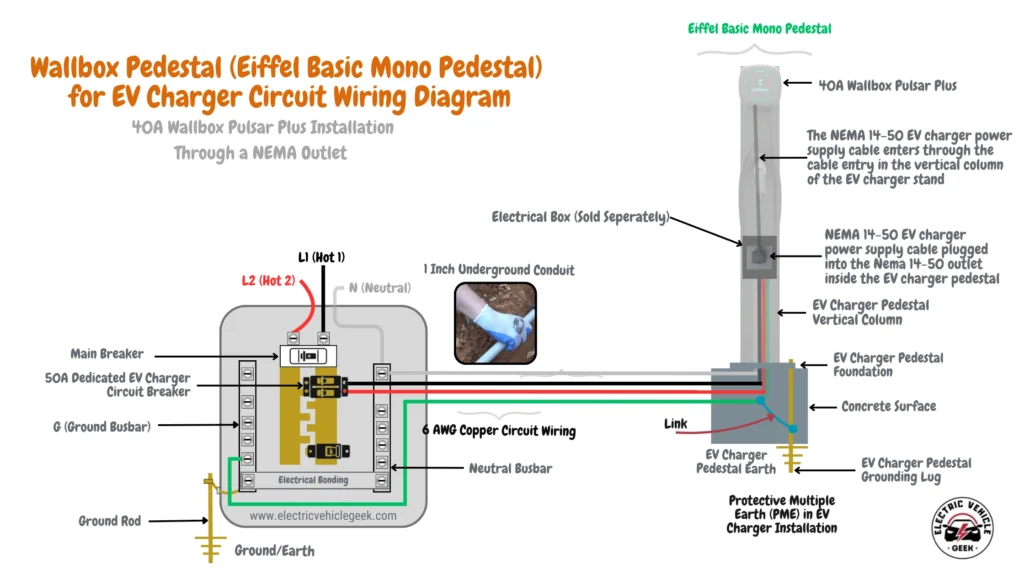
The diagram above highlights the electric vehicle circuit starting from the main electrical panel, passing through an underground conduit with 6 AWG wiring, and entering the pedestal’s vertical column, Inside the pedestal, the wires terminate at a NEMA 14-50 outlet installed within an electrical box mounted inside the pedestal. The plug-in EV charger connects directly to this outlet.
The diagram also illustrates a more advanced EV charger protective multiple earthing (PME) setup. This grounding system enhances electrical safety by connecting both the electrical panel, pedestal, and the plug-in EV charger to the earth, which we recommend for internal NEMA outlet installations in EV charger pedestals.
Mounting a NEMA Outlet on the EV Charger Pedestal Column
A more straightforward solution involves mounting an EV charger NEMA outlet externally on the EV charger pedestal column and protecting the outlet with a weatherproof receptacle box or an EV charger outlet cover.
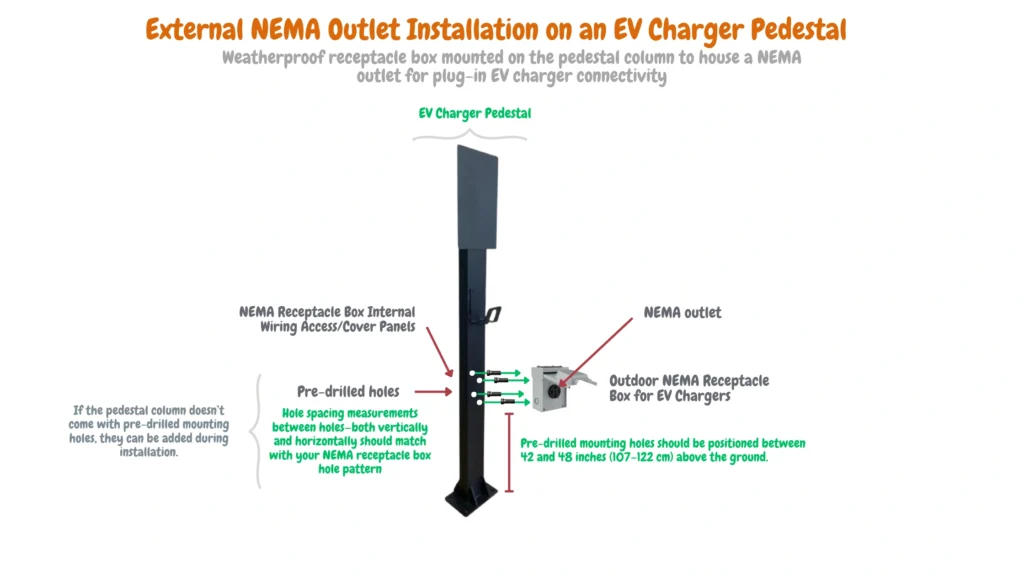
Mounting a NEMA outlet on the EV charger pedestal column is a straightforward and reliable installation method. It’s especially useful in retrofit scenarios where the pedestal’s internal column lacks sufficient space to house the outlet internally.
This method is particularly accessible for both licensed electricians and skilled DIY installers. It avoids the complexities of modifying the pedestal’s internal structure, making it a straightforward retrofit option. In most cases, the only modification required is drilling mounting holes to secure a weatherproof receptacle box to the exterior of the pedestal’s support column.
By using a properly rated outdoor receptacle box, installers can ensure a safe and code-compliant connection for the EV charger. This approach simplifies the installation process while still delivering a durable and professional finish, especially for pedestals with limited internal space.
We recommend this method to EV owners who frequently move their chargers between locations. It offers a practical solution for maintaining plug-and-play convenience, especially when a permanent hardwired setup isn’t ideal.
It’s also well-suited for pedestals with narrow or enclosed columns, such as the VIVO Outdoor EV Charging Stand. These models often can’t accommodate internal outlet mounting, but their exteriors can securely hold a receptacle box without compromising functionality.
VIVO Outdoor EV Charging Stand Review
While external mounting is effective, it’s important to use a weatherproof enclosure to shield the outlet from rain, dust, and UV exposure. When done correctly, this method provides a secure, efficient, and aesthetically clean solution for plug-in EV charger pedestal installations.
This detailed wiring diagram below illustrates a complete setup for installing an external NEMA 14-50 outlet on an EV charger pedestal—ideal for homeowners or electricians planning a plug-in EV charger configuration.
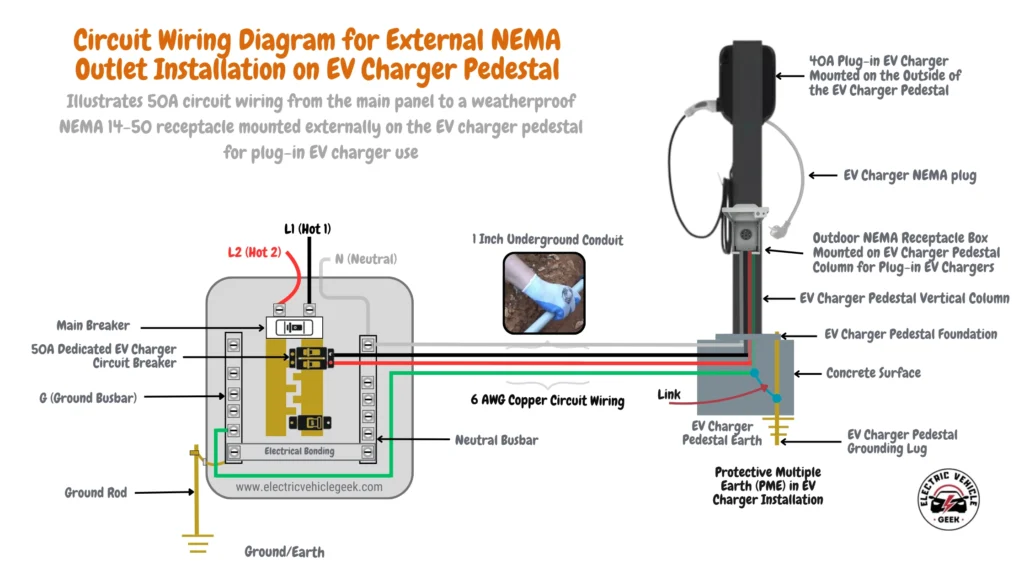
The visual breakdown shows a 50A dedicated circuit originating from the home’s main electrical panel, traveling underground via 6 AWG copper wiring in a conduit, and terminating at a weatherproof receptacle box mounted externally on the pedestal column.
The diagram also highlights key safety elements, including bonding at the panel, ground rod integration, and a local grounding lug at the pedestal. The mounted plug-in EV charger connects securely to the NEMA outlet, demonstrating a clean, code-compliant solution for outdoor installations. This setup offers an accessible, secure, and flexible alternative to hardwired chargers—especially when pedestal internals lack sufficient space.
We recommend implementing a Protective Multiple Earth (PME) system to ground the EV charger, metal outdoor NEMA receptacle boxes, and the NEMA outlet, particularly when using metal outdoor NEMA receptacle boxes mounted on EV charger pedestal columns for plug-in EV chargers, as shown in the diagram below.
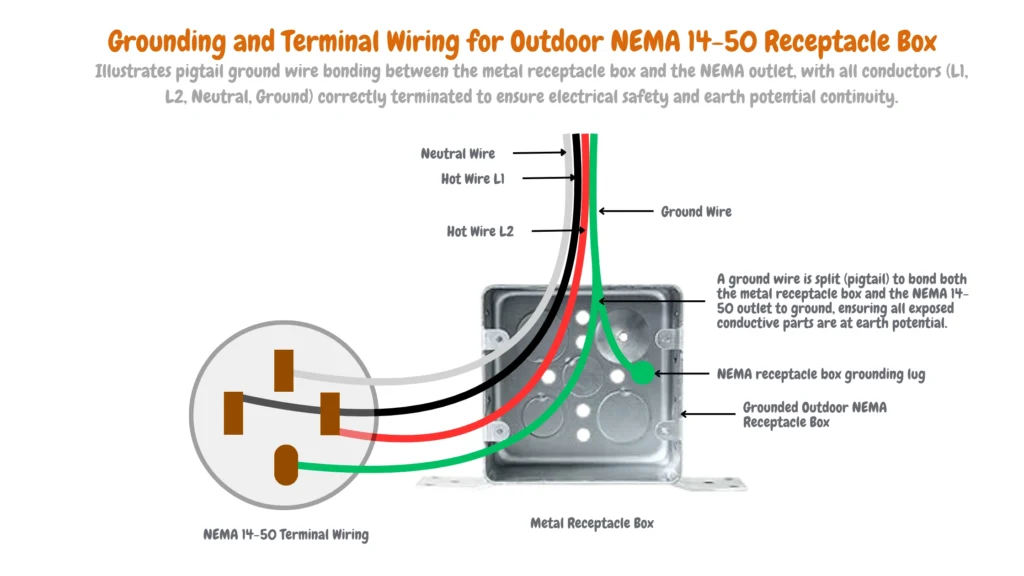
Protective Multiple Earthing (PME) improves safety by bonding the system neutral to multiple earth points, keeping exposed metal parts at earth potential. In outdoor EV charger setups—like a metal NEMA receptacle box on a pedestal—PME helps minimize shock risk and ensures quick disconnection during faults.
Integrating an EV Charger Lock Box into the Pedestal
Installing a lockable EV charger lock box on an EV charger pedestal is a simpler alternative, especially suitable for DIY installers since it’s less complex and more secure than other plug-in EV charger pedestal installation methods mentioned above.
This approach involves mounting the lock box on the surface where the EV charger would typically be installed and placing the EV charger NEMA outlet inside the EV charger lockbox for use with a plug-in EV charger.
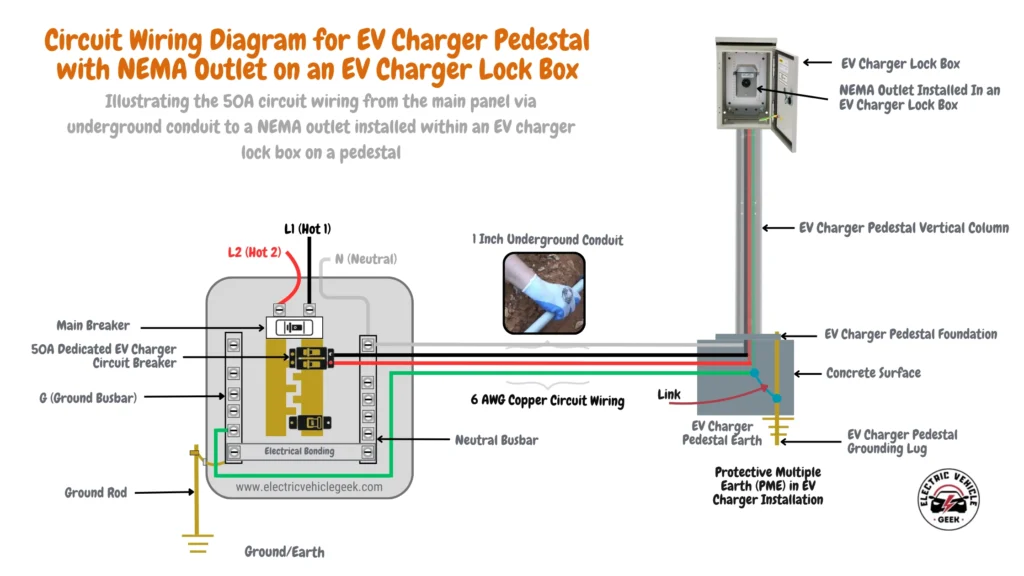
Several key factors must be considered in this type of installation: the EV charger pedestal must support the weight, the mounting surface must be compatible with your chosen EV charger lock box, and the lock box must have enough internal space to accommodate both the NEMA outlet and the EV charger.
Housing the plug-in EV charger outlet in a lockable EV charger enclosure mounted on an EV charger pedestal helps protect the charger from the elements, theft, vandalism, and unauthorized use. This makes it an excellent choice for shared or commercial spaces where security and controlled access are essential.
We recommend integrating an EV charger lockbox to an EV charger pedestal in heavy-duty EV charger pedestals that would be able to support the added weight of the EV charger lockbox, an EV charger outlet, plug-in EV charger weight, and also any other additional accessory you might install in the EV charger lockbox such as EV charger smart meters.
Examples of suitable EV charger pedestals include the Wallbox Pedestal for EV Charger, Autel Maxicharger Pedestal, Maizengauto EV Charger Pedestal, and BMZX Tesla Charger Pedestal, these models feature a heavy-duty base and sturdy vertical columns.
Maizengauto EV Charger Pedestal Review
BMZX Tesla Charger Pedestal Review
Autel Maxicharger Pedestal Review
Wallbox Pedestal for EV Charger Review
Among them, the Wallbox EV charger pedestal stands out for its enhanced stability, making it better suited to support heavier EV charger lock boxes thanks to its reinforced support base. However, it is also more expensive than the other options, reflecting its premium build quality and added structural support.
We recommend implementing a Protective Multiple Earth (PME) system when installing metal EV charger lockboxes on pedestal columns for plug-in EV chargers. PME ensures that all exposed conductive parts—including the metal lockbox housing and the NEMA outlet—are bonded to a common earth potential.
Earthing metal EV charger components, such as the EV charger lock box, significantly reduces the risk of electric shock and enhances the overall safety of integrating an EV charger lockbox into the EV charger pedestal.
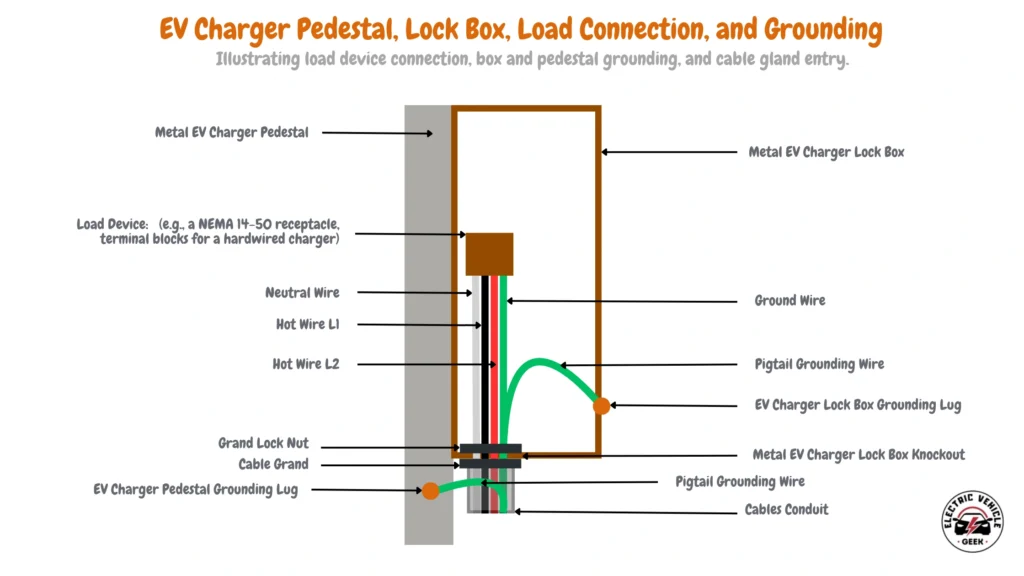
The diagram above shows how a 4-wire EV charger circuit is routed through a metal pedestal into an EV charger lock box housing a load device (e.g., NEMA 14-50 outlet). It highlights proper grounding using pigtail wires to bond both the metal lock box and pedestal to earth, ensuring safe PME-compliant installation for outdoor plug-in EV chargers.
Plug-In EV Charger Pedestal Installation Notes
This section covers everything from site planning and code compliance to conduit selection, Pedestal selection, Plug-in EV Charger selection, NEMA outlet choice, and grounding – ensuring your pedestal-mounted charger is safe, code-compliant, and ready for reliable use.
Pre-Installation Planning
Review Electrical Codes & Permit Requirements
Always check local building codes and permitting requirements before starting. Key NEC standards include:
- Article 625: Requires EV chargers to be mounted at least 24″ above grade outdoors (18″ indoors).
- Article 635: Mandates cable management for cables over 25 feet—highly recommended even for shorter runs.
Site Selection
Choose a site that:
- Minimizes wiring distance to reduce costs and EV charger voltage drop.
- Avoids underground obstructions like roots, driveways, or water lines.
- Offers safe and accessible parking space.
- Is sheltered from harsh weather.
- Complies with trench depth requirements (typically 18″).
Plug-In EV Charger Considerations
- Level 1 vs. Level 2 Compatibility: Plug-in EV chargers are available in both Level 1 (120V) and Level 2 (240V) configurations. Level 1 chargers use a standard household outlet (NEMA 5-15 or NEMA 5-20), offering slow charging suited for overnight use or emergencies. Level 2 chargers, typically plugged into a NEMA 14-50 or 6-50 outlet, deliver significantly faster charging and are ideal for daily driving needs.
- Confirm your EV charger panel supports your charger’s amperage (often 40A for plug-in EV chargers).
- Cross-check the charger’s voltage and phase compatibility.
- Ensure the selected charger suits your daily energy needs.
- Consider electrical panel upgrades if the existing system cannot support additional load.
- For accurate load assessments, refer to our [EV Charging Load Calculator].
Choosing the Right NEMA Outlet
Plug-in EV chargers require a dedicated NEMA outlet that aligns with the charger’s plug type and electrical specifications. Always verify that both the outlet configuration and the circuit rating are compatible with the charger’s voltage and amperage requirements to ensure safe and reliable operation.
A variety of NEMA outlet types are used in EV charging applications, including:
- 120V Outlets:
- NEMA 5-15 – Standard household outlet (Level 1, ~12A max)
- NEMA 5-20 – Slightly higher-rated 120V outlet for faster Level 1 charging
- 240V Outlets (Level 2):
- NEMA 6-15 / 6-20 – Compact 240V outlets for lower-amperage Level 2 chargers
- NEMA 10-30 / 14-30 – Often repurposed dryer outlets
- NEMA 6-50 / 14-50 – Common heavy-duty outlets for high-amperage Level 2 chargers (32–50A)
When selecting an outlet, factor in the charger’s maximum current draw, the cable length, and future-proofing considerations if upgrading later to a higher-powered EV or dual-EV setup.
When choosing a NEMA outlet:
- Verify your charger’s plug type and amperage rating.
- Confirm outlet compatibility with your charger and pedestal mounting.
- Ensure the outlet enclosure is weatherproof (NEMA-rated) for outdoor use.
- Use UL-listed or ETL-certified industrial-grade outlets with heavy-duty brass contacts and secure terminal clamps that can handle EV charger continuous loads.
Pro Tip: When installing the outlet inside a metal lock box or pedestal, ground the box and outlet using a pigtail ground wire. For optimal safety, implement a Protective Multiple Earth (PME) system to bond all exposed metal devices to earth potential.
Check out our guide on How to Install NEMA Outlets for EV Charging for step-by-step instructions and circuit diagrams on wiring NEMA outlets specifically for EV charging.
Choosing the Right EV Charger Pedestal
Select between a branded or universal pedestal. Ensure mounting compatibility of the plug-in EV charger and the NEMA outlet and check for pre-drilled patterns that match your plug-in EV charger’s bolt layout.
Selecting Conduit Type & Run Path
Decide between PVC or metal conduit based on the environment. Underground conduit is preferred for outdoor installations, while surface-mounted conduit works well for interior garages or above-grade runs. Ensure compliance with local codes and minimize bends and interference.
We recommend running the conduit from the main electrical panel directly to the pedestal’s lower entry port to establish a clean and secure wiring path. For conductor selection, use solid copper THWN or THWN-2 rated for 90°C. THWN-2 is particularly well-suited for this type of installation, as it is rated for continuous use in wet or damp environments, which includes outdoor and underground conduits as defined by the National Electrical Code (NEC).
If you’re planning a direct burial installation, USE (Underground Service Entrance) or URD (Underground Residential Distribution) cable is also acceptable. These types are designed for direct burial without conduit but may also be installed inside conduit when added protection or routing flexibility is needed. This approach ensures long-term performance, code compliance, and electrical safety in demanding outdoor environments.
Securing the Pedestal for Plug-In EV Charger Installations
For a durable and code-compliant plug-in EV charger pedestal installation, start by selecting a level, stable surface for mounting the pedestal. Outdoor environments demand a strong foundation to support the weight of the charger and maintain long-term stability under varying weather conditions.
We recommend installing the pedestal on a precast or custom-poured concrete footing, ideally with the following dimensions:
- Length: 600 mm
- Width: 600 mm
- Height: 400 mm
These dimensions ensure a broad footprint for structural support and anchor bolt engagement, minimizing the risk of tilt, movement, or stress over time.
Foundation Design and Pedestal Anchoring
A supporting visual titled “EV Charger Pedestal Foundation” breaks down the key structural elements, combining a detailed line diagram of the pedestal base and a 3D view of the recommended concrete block.

Pedestal Mounting Components (Upper Section of Diagram)
- Vertical Support Post: Forms the backbone of the pedestal, internally channeled for cable protection and easy wiring access.
- Base Plate with Mounting Holes: A flat steel flange at the bottom of the column is designed for bolting to a concrete surface. Often includes optional gasket seals to improve waterproofing and stability.
- Anchor Bolts: Threaded fasteners shown extending downward through the base plate into the concrete. Critical to secure the pedestal firmly to the foundation, especially in windy or high-traffic areas.
Concrete Foundation Elements (Lower Section of Diagram)
- Surface Mounting Plate: A pre-drilled top plate resting on the concrete block, designed to align with the pedestal’s bolt pattern.
- Central Conduit Opening: A hole through the top center of the block, enabling direct entry for electrical cables into the pedestal from below.
- Side Conduit Arches: Grooved or notched cutouts along the lower block edges to route and protect underground conduits.
Installation Tips from the Field
- Always confirm pedestal base compatibility with your selected concrete block. Most manufacturers offer templates or dimensional specs for anchor placement.
- Use corrosion-resistant anchor bolts rated for outdoor use, and torque them to spec to prevent loosening over time.
- Double-check pedestal alignment and leveling during installation to ensure proper charger orientation and user accessibility.
- For plug-in chargers, ensure the pedestal’s internal raceway allows safe conduit routing to the NEMA 14-50 or 6-50 outlet, and the outlet box is weather-rated for exterior use.
Tools & Materials Checklist
- EV Charger Circuit Conduit (PVC or Metal) – Choose based on site conditions and local code requirements. Use PVC conduit for corrosion resistance in underground runs, or metal conduit for added durability and grounding continuity above ground.
- EV Charger Circuit Wiring – Select the correct EV charger installation wire gauge to handle the charger’s amperage. Use THHN or THWN-2 insulation for high-temperature and wet-location ratings. Always follow NEC guidelines for wire sizing and conduit fill.
- NEMA Outlet (14-50 or 6-50) – Choose based on charger specs and outdoor durability.
- Disconnect Switch, Circuit Breaker & Junction Box – Include safety shut-off, proper EV charger breaker sizing, and secure wiring junctions.
- Anchors, Bolts & Mounting Template – For securely fastening the pedestal to the slab or surface.
- Multimeter, Level, Conduit Bender, Drill – Essential tools for testing, alignment, bending conduit, and mounting.

James Ndungu is a certified EV charger installer with over five years of experience in EVSE selection, permitting, and installation. He holds advanced credentials, including certification from the Electric Vehicle Infrastructure Training Program (EVITP) and specialized training in EV charging equipment and installation, as well as diplomas in EV Technology and Engineering Fundamentals of EVs. Since 2021, James has tested dozens of EV chargers and accessories, sharing expert insights into the latest EV charging technologies.
